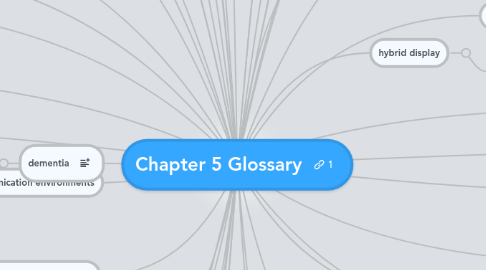
1. access barriers
1.1. Situations preventing communication due to a patient's capabilities and resources using the AAC
2. aided
2.1. A symbol that needs something external in order for the message to be conveyed
2.1.1. Draw a picture
2.1.2. Type a message
3. amyotrophic lateral sclerosis
3.1. A communication degenerative disease that results in the deterioration of speech skills and respiratory functioning
3.1.1. Lou Gehrig's Disease
4. augmentative and alternative communication
4.1. Alternate approach to treating a communication disorder by focusing on how the disorder affects a patient's daily living and how to cope more productively within their life.
5. autism spectrum disorders
5.1. A development disorder characterized by lack of social interaction or communication limitations
6. cerebal palsy
6.1. A neuromotor impairment that occurs from damage prior,during or after brith
7. childhood apraxia of speech
7.1. A speech disorder that causes the lack of control in speech movement
7.1.1. Development apraxia of speech
8. coded access
8.1. When someone uses a set of symbols in a particular order from the set.
8.1.1. Mores code
9. communication competence
9.1. The ability to work toward communication at an independent level
10. communication environments
11. dementia
11.1. A degenerative that causes impaired communication
11.1.1. Huntington's Disease
11.1.2. Alzheimer's Disease
12. direct selection
12.1. Direct motor act not based on time
12.1.1. 4 Types
13. electronic
13.1. devices that are technologically generated for speech
14. independent communciation
15. indirect selection
15.1. Indirect motor act
16. information transfer
16.1. Information that is both sent and received
17. intellectual disability
17.1. Having significant limits in regards to cognitive functioning and behavior
17.1.1. Mental retardation
18. social etiquette
18.1. Ability to be polite and use social standards to communicate with others
19. social roles
19.1. The part a person plays in their culture/society
19.1.1. Mother/father
19.1.2. Daughter/son
19.1.3. Employee/Employer
20. speech generating device
20.1. A device that produces words/phrases for a patient in lieu of speaking and being misunderstood
20.2. A device that produces words/phrases for a patient in lieu of speaking and being misunderstood
20.2.1. Cerebal Palsy patient with unpredictable motor skills
21. static
21.1. Symbols that don't need movement or change to understand the meaning
21.1.1. Photograph
22. strategy
22.1. The way symbols are arranged and conveyed
22.1.1. 3rd component of AAC
23. stroke
23.1. When the blood supply to the brain stop or the blood vessel rupture creating brain damage
24. symbol
24.1. Something that represents something else
24.1.1. Acoustic
24.1.2. Tactile
24.1.3. Manual
24.1.4. Graphic
25. technique
25.1. The manner message are transmitted
25.1.1. Direct Selection
25.1.2. Indirect Selection
26. visual scene display
26.1. Displays using pictures or photos to represent a place or situation
27. Traumatic brain injury
27.1. Injury to the brain caused by a traumatic situation
27.1.1. Falling off a motorcycle
27.1.2. Hitting head on pavement
28. AAC System
28.1. 4 different components used to enhance communication
28.1.1. symbols
28.1.2. strategies
28.1.3. aid
28.1.4. technique
29. aid
29.1. A device used to assist someone in sending or receiving a message in order to assist with conveying speech or writing
30. communication roles
30.1. The specific part a person plays in communicating
31. complex communication needs
31.1. Severe speech, language and/or motor/cognitive impairments that prevent patients from communicating on a daily basis effectively
31.1.1. severe communication disorders/impairments
32. comprehensive AAC assessment
32.1. Test to measure and identify what contributors factors affects a patients communication skills
33. context-dependent communication
33.1. Individuals with more reliable methods of communication but limited to only a few people or contexts at the time
34. dynamic
34.1. Symbols that require movement to understand the meaning of them
34.1.1. Gestures
35. dynamic display
35.1. A visual change seen once a symbol is chosen
36. emerging communication
36.1. Individuals who are able to communication with limited symbols but still gaining consistent methods of communication
36.1.1. Infant vocalizations/babbles
37. fixed display
37.1. A display that remains the same before and after a symbol is chosen
38. hybrid display
38.1. An AAc system that uses a combination of display types
39. iconicity
39.1. To what extent symbols visually look like what they're referring to
40. multidisplinary team
40.1. A group of professionals that assist in the AAC assessment
40.1.1. Speech Pathologist
40.1.2. PT/OT
40.1.3. Rehabilitation engineer
40.1.4. Dr/Nurse/Social Worker
41. multimodal
41.1. when people use various communication forms to convey their communication goal.
41.1.1. listening
41.1.2. reading
41.1.3. talking
41.1.4. writing
41.1.5. sign language
42. opaque
42.1. When symbols look little like what they are referring to
43. opportunity barriers
43.1. Circumstances preventing a person to participate in activities involving communication
43.1.1. Policy
43.1.2. Practice
43.1.3. Skill
43.1.4. Knowledge
43.1.5. Attitude
44. Parkinson's Disease
44.1. A disease that causes deterioration of basal ganglia in the CNS
45. scanning
45.1. A set of symbols configured by a communication device using a switch
46. social closeness
46.1. Interactions between one another to develop relationships using communication
47. unaided
47.1. Symbols that use only your body
47.1.1. Speaking
47.1.2. Gesturing
47.1.3. Vocalizing
